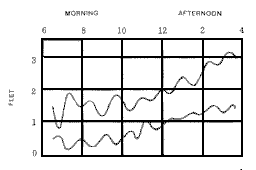 |
Science Frontiers ONLINE No. 101: Sep-Oct 1995 |
|
|
Death waves and seebars
A comprehensive, 12-page article on seiches appeared in the July/August issue of American Scientist, and it was awash with curious observations. A seiche (pronounced "saysh") is a rhythmic rocking motion of a body of water that has been disturbed by natural forces, such as sudden weather changes and, especially, earthquakes.
A famous example of the latter seichedriving force occurred on March 27, 1964, when the Great Alaskan Earthquake sent seismic waves rippling around the globe. Fourteen minutes after this quake, the tremors reached the U.S. Gulf coast and triggered numerous seiches in bays, harbors, canals, bayous, etc. Some crest-to-trough waterlevel oscillations reached 2 meters in amplitude. Startling though these seiches were to Gulf fishermen, most seiches are wellexplained. Bodies of water that are mostly enclosed have natural frequencies of oscillation or "sloshing," just as do coffee cups and bathtubs. The Alaskan quake just operated on a larger scale than a bump to your coffee cup!
 Short-period oscillations in the tidal record from Puerto Princesa, Palawan Island, Philippines. These are coastal seiches, but hardly "death waves"! |
Puerto Rican island of Magueyes, coastal seiches are most common about 7 days after new and full moons, suggesting a tidal influence. Oceanographers G.S. Giese and R.B. Hollander think that these coastal seiches are the consequence of internal waves (solitons*) formed at the southeastern edge of the Caribbean where tidal effects are particularly powerful 2 days after new and full moons. These slowmoving internal waves take 5 days to reach Puerto Rico, where they emerge as coastal seiches. Similar internal waves created by tidal currents at the edges of the continental shelves and deepwater sills may explain the mysterious coastal seiches recorded in the Anadaman and Sulu Seas. So far, no one has suggested origins for the Irish "death waves" and Baltic "seebars." (Korgen, Ben J.; "Seiches," American Scientist, 83:330, 1995.)
*Internal waves or solitons move, mostly unseen at the surface, along the ocean's thermoclinethe plane separating warm surface water from much colder water below. The vertical amplitude of the solitons may be hundreds of meters, but at the surface they are represented by only small, gently domed, slowly moving waves or by regions of turbulence. Coastal seiches appear when the solitons impinge on coasts. For more on unusual waves and solitons, see: Earthquakes, Tides, etc. This book is listed here.